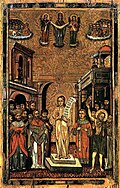References
- ↑ "Unicode character database". The Unicode Standard. Retrieved 2023-07-26.
- ↑ "Enumerated Versions of The Unicode Standard". The Unicode Standard. Retrieved 2023-07-26.
Notes and manuals
- Nicholas, Nick. "Unicode Technical Note: Byzantine Musical Notation Version 1.1: February 2006" (PDF). The Unicode Consortium. Retrieved 28 April 2015.
- Terzopoulos, Constantine. "Ephesios™ Byzantine music symbol computer font set: User's Guide" (PDF). Psaltic Notes. Archived from the original (PDF) on July 12, 2014. Retrieved 28 April 2015.
